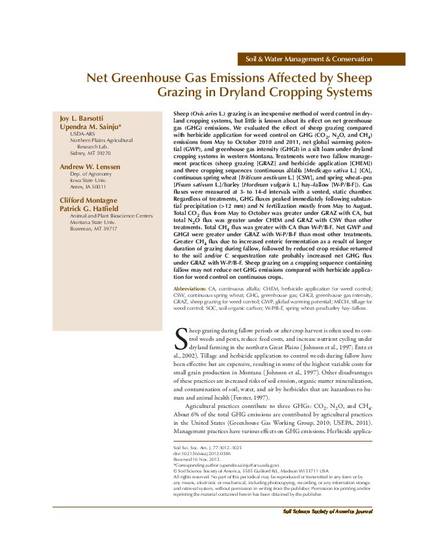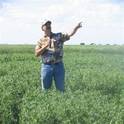
Sheep (Ovis aries L.) grazing is an inexpensive method of weed control in dryland cropping systems, but little is known about its effect on net greenhouse gas (GHG) emissions. We evaluated the effect of sheep grazing compared with herbicide application for weed control on GHG (CO2, N2O, and CH4) emissions from May to October 2010 and 2011, net global warming potential (GWP), and greenhouse gas intensity (GHGI) in a silt loam under dryland cropping systems in western Montana. Treatments were two fallow management practices (sheep grazing [GRAZ] and herbicide application [CHEM]) and three cropping sequences (continuous alfalfa [Medicago sativa L.] [CA], continuous spring wheat [Triticum aestivum L.] [CSW], and spring wheat–pea [Pisum sativum L.]/barley [Hordeum vulgaris L.] hay–fallow [W-P/B-F]). Gas fluxes were measured at 3- to 14-d intervals with a vented, static chamber. Regardless of treatments, GHG fluxes peaked immediately following substantial precipitation (>12 mm) and N fertilization mostly from May to August. Total CO2 flux from May to October was greater under GRAZ with CA, but total N2O flux was greater under CHEM and GRAZ with CSW than other treatments. Total CH4 flux was greater with CA than W-P/B-F. Net GWP and GHGI were greater under GRAZ with W-P/B-F than most other treatments. Greater CH4 flux due to increased enteric fermentation as a result of longer duration of grazing during fallow, followed by reduced crop residue returned to the soil and/or C sequestration rate probably increased net GHG flux under GRAZ with W-P/B-F. Sheep grazing on a cropping sequence containing fallow may not reduce net GHG emissions compared with herbicide application for weed control on continuous crops.
Available at: http://works.bepress.com/andrew_lenssen/12/

This article is from Soil Science of American Journal 7 (2013): 1012–1025, doi:10.2136/sssaj2012.0386.